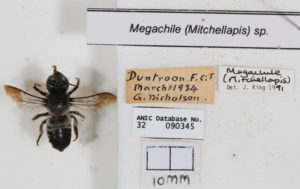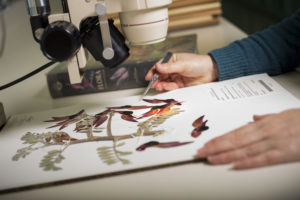THE National Research Collections Australia at CSIRO houses 15 million biological specimens - that’s 39 times as many objects as the Louvre. From eucalypts collected by Joseph Banks to native bees numbering more than 50,000 the collections are a goldmine of biodiversity information and growing daily.
“We have a huge project underway to digitise the collections and make them available online,” says digitisation manager Simon Checksfield. “The grand purpose in digitising our collections is to unlock the information in the physical world and release it into the digital world.”
“Digitisation is about unlocking big data to solve global problems:” he says. “Our collections exist for research, for solving problems like monitoring species’ responses to climate change. All of that can be done more easily, more quickly and on a grander scale when the specimens are digital as well as physical.”

Staff and volunteers at the Australian National Insect Collection have just completed digitising CSIRO’s collection of native bees.
“Pollination is critical to the food supply chain and understanding how native bees fit into that is very critical. The honey bee is not the whole story,” says Checksfield.
Working from anywhere in the world on the DigiVol platform - https://digivol.ala.org.au - citizen scientists viewed photographs of the bees and transcribed the information on the label attached to each bee specimen.
Labels are almost as important as the physical specimens, describing when and where a specimen was collected, identifying what it is and listing other useful information, like the type of plants where an insect was collected.
Digitisation provides a back-up of the data associated with the specimens. At the Australian National Herbarium, staff are digitising the type specimens among their holdings. These revered specimens are stored together in a safe room, protected from fire. Types are used to permanently link a species name to a physical specimen and serve as a vital reference when species get their names in a muddle. High-resolution images of the herbarium’s types are available online for researchers to use, a quicker and safer option than loaning precious specimens.
Herbarium staff are also digitising the seeds of weedy daisies, removing seeds from expertly identified daisy specimens held in the herbarium’s collection and photographing them under a microscope. The photographs are being used to illustrate an online identification key for identifying daisy seeds that may accidentally be brought into Australia on cargo. The key helps stop new weeds becoming established in Australia and prevents existing weeds being strengthened by new genetic diversity.

Digitisation also happens on the go. Specimens that are born digital have a digital record created alongside the physical one as part of the collecting process.
Scientists from the Australian National Fish Collection go to sea aboard CSIRO’s RV Marine National Facility research vessel Investigator, sampling fish species from Australia’s waters. In labs on board they zoom in on species identifications, record location information and photograph specimens before their colours are lost during the preservation process. Back on land they x-ray some fishes to resolve species identifications and gather information necessary for describing species that are new to science.
Data for all identified species are available on the Atlas of Living Australia.
For all fishes, except recently recognised species, a photo and a map showing their known distribution can be found on FishMap.
“As a country we’re blessed with an incredible diversity of living things,” says Checksfield. “Around three quarters of the species that live here don’t exist anywhere else in the world. Collections are huge part of how we understand and manage our biodiversity.
“Digitisation is making the data held within our collections easily available to have bigger impacts in areas like conservation, biosecurity and climate change. For me, the success of digitising will be when someone does something with our information that we’ve never thought of before.”
Read more about our National Research Collections of Australia
